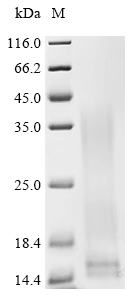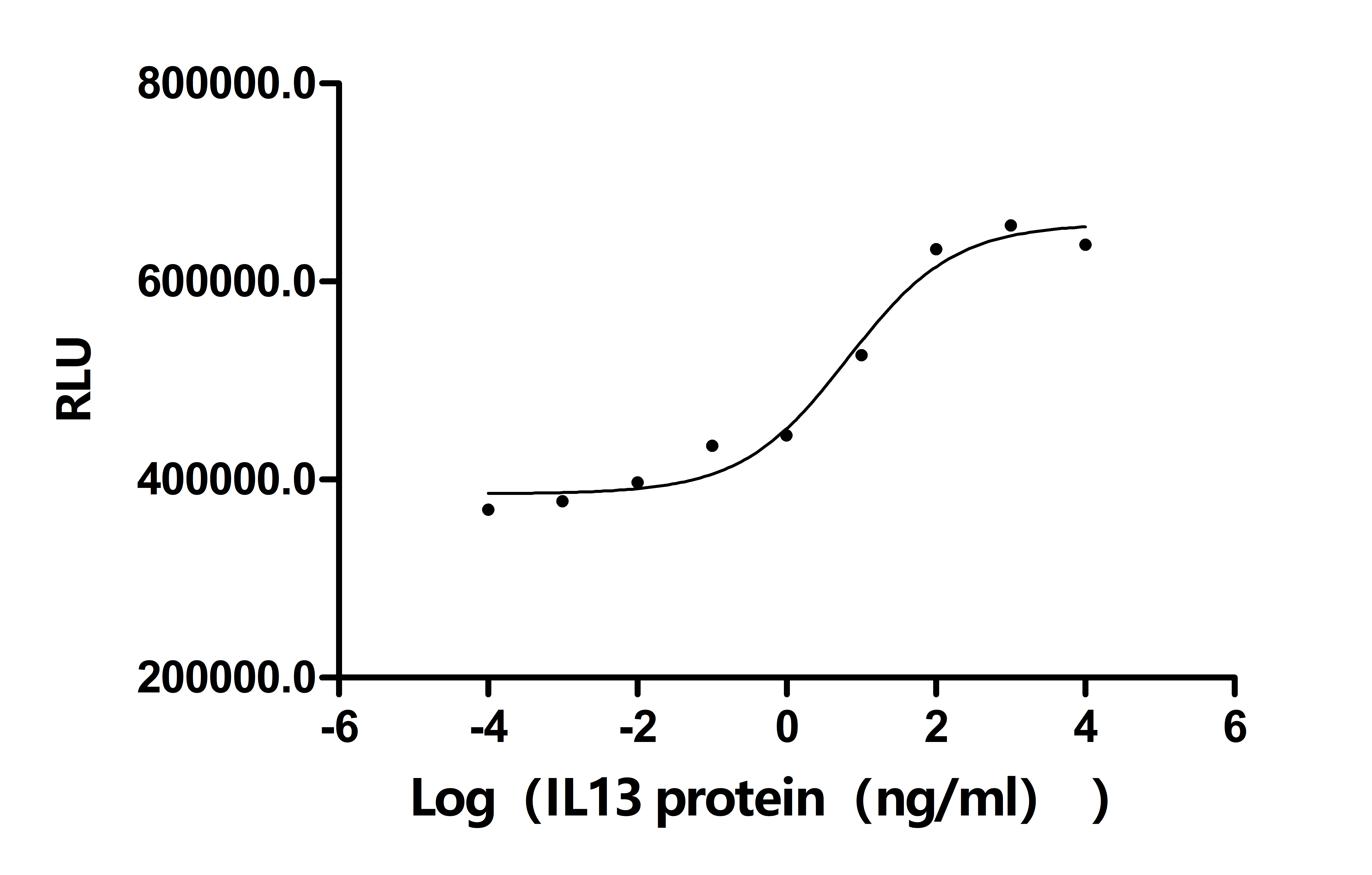The recombinant dog IL13 protein is derived from the mammalian cell expression system. The target gene encodes the 19-131aa of the dog IL13. It is labeled with Ca -terminal 10xHis-tag. It has been validated to be biologically active in a proliferation assay as it stimulates the proliferation of TF-1 cells in a dose-dependent manner, with the ED50 of 3.930-20.07 ng/mL. Its purity exceeds 95% as determined by SDS-PAGE, and its endotoxin level is less than 1.0 EU/ug as measured by the LAL method.
The IL13 protein in dogs plays a significant role in modulating immune responses and inflammation, similar to its functions in other species. IL13 is primarily produced by T-helper type 2 (Th2) cells, but it can also be secreted by various other immune cells such as mast cells, basophils, and eosinophils [1]. This cytokine is crucial in regulating allergic responses and inflammation, particularly in conditions like atopic dermatitis, which is prevalent in dogs [2].
One of the primary functions of IL13 is its involvement in the Th2 immune response, which is characterized by the production of IgE and the activation of eosinophils. This response is essential for combating parasitic infections but can lead to allergic reactions when dysregulated [3]. In the context of canine health, variations in the IL13 gene have been linked to atopic dermatitis, suggesting that specific polymorphisms may alter the protein's function and contribute to disease susceptibility [2]. The variant Ala81 of canine IL13 is predicted to significantly affect its conformation and function, potentially influencing the severity of allergic responses [2].
IL13 also plays a pivotal role in tissue remodeling and fibrosis. It promotes the differentiation of fibroblasts into myofibroblasts, which are involved in collagen deposition and tissue repair processes [4]. This function is particularly relevant in chronic inflammatory conditions where excessive fibrosis can lead to organ dysfunction. In dogs, as in other mammals, IL13 signaling is mediated through its receptors, primarily IL13Rα1 and IL13Rα2, which activate downstream signaling pathways such as JAK/STAT6, leading to the transcription of genes associated with inflammation and fibrosis [5][6].
Moreover, IL13 has been shown to influence the behavior of various immune cells in the central nervous system (CNS). Studies indicate that IL13 can modulate microglial activation and promote an anti-inflammatory environment, which is beneficial in neuroinflammatory conditions [7][8]. This suggests a broader role for IL13 beyond peripheral immune responses, extending into neuroimmune interactions, which may have implications for conditions affecting the CNS in dogs.
References:
[1] A. Brahimaj, S. Ligthart, M. Ghanbari, M. Ikram, A. Hofman, O. Franco, et al. Novel inflammatory markers for incident pre-diabetes and type 2 diabetes: the rotterdam study, European Journal of Epidemiology, vol. 32, no. 3, p. 217-226, 2017. https://doi.org/10.1007/s10654-017-0236-0
[2] K. Tanaka, M. Yamamoto-Fukuda, T. Takizawa, H. Shimakura, & M. Sakaguchi. Association analysis of non-synonymous polymorphisms of interleukin-4 receptor-α and interleukin-13 genes in canine atopic dermatitis, Journal of Veterinary Medical Science, vol. 82, no. 9, p. 1253-1259, 2020. https://doi.org/10.1292/jvms.20-0301
[3] F. Vladich, S. Brazille, D. Stern, M. Peck, R. Ghittoni, & D. Vercelli. Il-13 r130q, a common variant associated with allergy and asthma, enhances effector mechanisms essential for human allergic inflammation, Journal of Clinical Investigation, vol. 115, no. 3, p. 747-754, 2005. https://doi.org/10.1172/jci22818
[4] A. Adhyatmika, K. Putri, E. Gore, K. Mangnus, C. Reker‐Smit, D. Schuppan, et al. Osteoprotegerin expression in liver is induced by il-13 through tgf-β,, 2020. https://doi.org/10.1101/2020.12.11.421479
[5] G. Li, A. Wu, D. Qi, F. Cui, Y. Zeng, F. Xie, et al. Differential effects of peptidoglycan on colorectal tumors and intestinal tissue post-pelvic radiotherapy, Oncotarget, vol. 7, no. 46, p. 75685-75697, 2016. https://doi.org/10.18632/oncotarget.12353
[6] L. Hsi, S. Kundu, J. Palomo, B. Xu, R. Ficco, M. Vogelbaum, et al. Silencing il-13rα2 promotes glioblastoma cell death via endogenous signaling, Molecular Cancer Therapeutics, vol. 10, no. 7, p. 1149-1160, 2011. https://doi.org/10.1158/1535-7163.mct-10-1064
[7] S. Taj, D. Blon, C. Hoornaert, J. Daans, A. Quarta, J. Praet, et al. Targeted intracerebral delivery of the anti-inflammatory cytokine il13 promotes alternative activation of both microglia and macrophages after stroke, Journal of Neuroinflammation, vol. 15, no. 1, 2018. https://doi.org/10.1186/s12974-018-1212-7
[8] D. Blon, C. Guglielmetti, C. Hoornaert, A. Quarta, J. Daans, D. Dooley, et al. Intracerebral transplantation of interleukin 13-producing mesenchymal stem cells limits microgliosis, oligodendrocyte loss and demyelination in the cuprizone mouse model, Journal of Neuroinflammation, vol. 13, no. 1, 2016. https://doi.org/10.1186/s12974-016-0756-7





